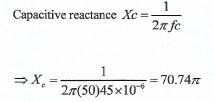QUESTIONS
SECTION A (48 marks)
Answer all the questions in this section in the spaces provided.
-
- Name four conducting materials used in electrical circuits.(2 marks)
- State three advantages of circuit breakers over rewirable fuses.(3 marks)
-
- State two reasons that may cause an entrepreneur to fail in business(2 marks)
- State two causes of accidents in a workshop.(2 marks)
-
- State two functions of the try square.(2 marks)
- Make a free hand isometric drawing of a one gang one way switch.(3 marks)
- State two functions of the controlling torque in analogue instruments.(2 marks)
- Name two types of moving coil instruments.(1 mark)
-
- Outline three methods used in demagnetising a magnet.(3 marks)
- Name two non-magnetic materials.(1 mark)
-
- Name three types of diodes and for each case sketch their symbols. (3 marks)
- Explain the difference between an ordinary switch and a P.N. junction diode. (2 marks)
- State two ways of disposing electrical waste materials.(1 mark)
- Figure 1 shows an electric circuit. Calculate the:
- Supply voltage;
- Reading on ammeter A;
- Value of resistor R.(6 marks)

-
- Draw a labelled diagram of a carbon resistor.(3 marks)
- Define the term 'inductance'(2 marks)
-
- Name three tests carried out in a completed electrical installation and in each case, state the instrument used.(3 marks)
- State two options that one can pursue in electrical engineering field after the completion of secondary education.(1 mark)
SECTION B (52 marks)
Answer any four questions from this section in the spaces provided
-
- Draw a labelled diagram of a single phase double wound core type transformer.(5 marks)
- A 240v/12v ideal transformer is connected to a lamp of 120 watts.
Calculate:- Current taken from the supply
- Transformer turns ratio (5 marks)
- Explain the purpose of a centrifugal switch in an A.C. single phase motor. (3 marks)
-
- With the aid of a labelled diagram of a P.N.P. transistor, explain the following:
- Emitter
- Base
- Collector (9 marks)
- Draw the truth table for an OR logic gate(4 marks)
- With the aid of a labelled diagram of a P.N.P. transistor, explain the following:
- Figure 2 shows three views of a simple shaped block drawn in orthographic first angle projection. Draw the block in isometric projection making comer P the lowest point.(13 marks)
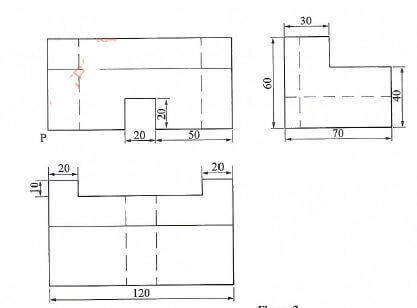
Figure 2 -
-
- Figure 3 shows a voltage sine wave produced by an alternator,
Name the parts labelled A-F. (3 marks)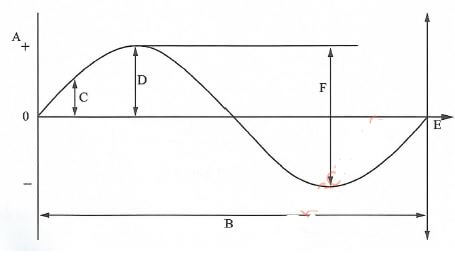
Figure 3 - A supply voltage has a mean value of 120v.
Determine its:- Maximum value
- rms value (3 marks)
- Figure 3 shows a voltage sine wave produced by an alternator,
- Figure 4 shows an RC circuit.
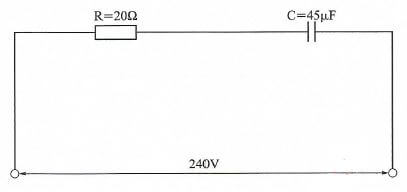
Figure 4
Calculate the:- Capacitive reactance;
- Impedance;
- Supply current. (5 marks)
- Name four applications of electromagnets. (2 marks)
-
-
- Outline the action to be taken on a victim found in contact with live conductors and is very unconscious.(5 marks)
- State two I.E.E. regulation requirements regarding 13A socket outlets.(2 marks)
-
- Draw a circuit diagram of a switch start fluorescent fitting. (4 marks)
- A fluorescent lamp fails to start and there is no end glow. State two possible causes for this action.(2 marks)
MARKING SCHEME
-
- Four types of conducting materials.
- Copper
- Aluminum
- Zinc
- Silver
- Iron
- Advantages of circuit breakers.
- The overload tripping characteristics are set by the manufacturer and cannot be altered.
- Faulty circuits can be easily identified.
- Supply can be quickly and easily restored when fault has been cleared.
- Four types of conducting materials.
-
- Reasons that may cause a business or entrepreneur to fail.
- Selection of business (poor).
- Poor marketing.
- Initial starting capital low.
- Poor location of business.
- Causes of accidents in a workshop.
- Carelessness
- Ignorance
- Improper dressing
- Reasons that may cause a business or entrepreneur to fail.
-
- Parts of a d.c machine
- Commutator
- It is made of copper bars insulated from each other by Mica. The armature coils are connected to the commuter bars and so make contact with brushes.
- Armature
- It's the rotating part of the machine and usually consists of laminated iron cylinder with slots equally spaced around its circumference. Coils are usually fitted into the slots to form the armature winding.
- Commutator
- Iron losses
- Hysteresis loss is the heating of the core as a result of internal molecular structure reversals which occurs as the magnetic flux alternates.
- Eddy current loss is the heating of the core due to emf's being induced not only in the transformer windings but also in the core.
- Parts of a d.c machine
-
-
- Try square
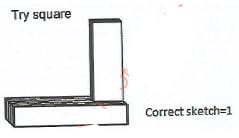
- This is used for setting lines at right angles to a face or edge and for testing surfaces at 90° to each other. (1 mark)
- Try square
- Switch
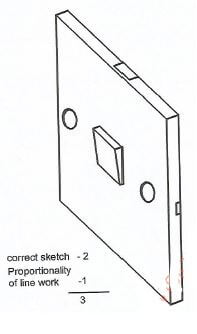
-
-
- Functions of a controlling torque
- It increases with the deflection of the moving system so that the final position of the pointer will be according to the magnitude of electrical quantity to be measured.
- It brings the pointer back to zero position.
- Types of moving coil instruments
- Permanent magnet moving type.
- Dynamo type of meter.
- Functions of a controlling torque
-
- Methods of demagnetization
- Heated to bright red hot then cooled away from a magnetic field.
- Subjected to mechanical shocks such as jarring, vibrations or hammering
- Inserted in an alternating current coil and then slowly withdrawing from the coil.
- Non-magnetic materials
- Copper
- Aluminum
- Silver
- Paper
- Methods of demagnetization
-
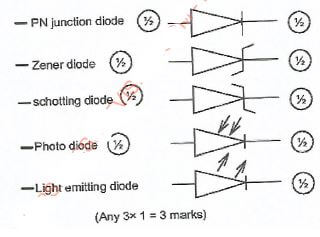
(Any 3 x 1 = 3 marks)- Difference between a switch and a diode.
- The switch being mechanical is capable of conducting current in either direction while the diode only allows current to flow through it in one direction
- Disposal of electrical waste
- Burying deep in the ground.
- Recycling, removing useful components.
-
- P.d. across R is the same as the supply voltage v.
Hence supply voltage V=4 x 5=20V. - Reading on ammeter I2 = V = 20 = 2A
R2 10 - Current flowing through R3
11-4-2 = 5A
Hence R3 = V = 20 = 4Ω
I3 5
- P.d. across R is the same as the supply voltage v.
-
- Carbon resistor
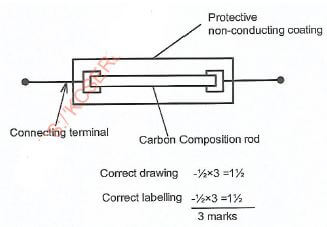
- Inductance
- It's the property of a circuit whereby there is E.M.F. induced into the circuit by the change of flux linkages produced by a current change.
- Carbon resistor
-
- Tests carried out on an electrical installation
- Polarity test; ohmmeter
- Continuity test; ohmmeter
- Insulation test; megger
- Earth test; Earth loop tester.
- Electrical Engineering
- Power option
- Telecommunication option
- Instrumentation option
- Electronics
- Tests carried out on an electrical installation
-
-
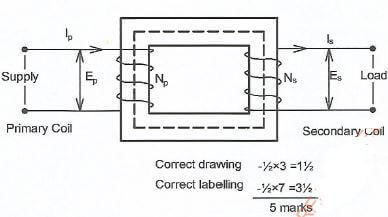
-
-
V1 = 240, V2 = 12V
I2 = P = 120 = 10A
V2 12
V1 = I2 from which I1 = I2 (V2)
(V1)
Hence current taken from the supply 11
= I1 = 10x12 +0.5A
240 - Turns ratio
N1 = V1 = 240 = 20
N2 V2 12
-
- Centrifugal switch
- It is normally attached to the rotating part of the motor and is normally closed.
- As the motor starts rotating and approaches the synchronous speed the switch opens thereby removing the starting winding from the supply and the motor runs with only one winding.
- The centrifugal switch is used to isolate the starting winding when the motor starts so that the winding does not burn since it is rated to run continuously.
-
-
-
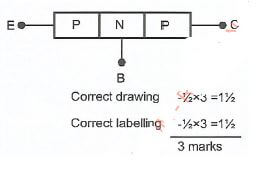
Emitter -it forms the left hand section or region as shown. It is more heavily doped than any other regions because its function is to supply majority carriers.
Base-it forms the middle section. It is very thin as compared to other regions and lightly doped.
Collector-it forms the right hand side section or region of the transistor. It's function is to collect majority charge carriers coming from the emitter. - Truth Table OR gate
A B C 0 0 0 0 1 1 1 0 1 1 1 1
-
-
-
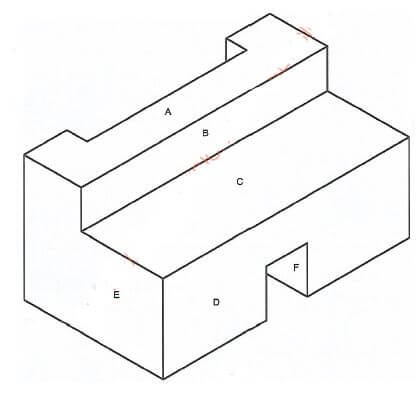
FACES
A - 2
B - 1
C - 1
D - 3
E - 3
F - 1
Corner P - 1
Line work/neatness - 1
13 marks total
-
-
-
- A-Voltage
B-Cycle
C- Instantaneous value
D- Peak value
E-Time
F-Peak to peak value - For a sine wave
- Mean value = 0.637 x maximum value
Hence maximum value = mean value
0.637
= 120 = 188.38V
0.637 - R.M.S. value = 0.707 x Max value
= 0.707 x 188.38
= 133.187V
- Mean value = 0.637 x maximum value
- A-Voltage
- R = 20Ω
V = 240V
C = 45μF = 45x10-6F
F = 50Hz - Applications of electromagnets
- Loudspeakers
- Measuring instruments
- Motors, generators
- Door bells, buzzers, chimes
- Circuit breakers
- Relays
-
-
- Action to be taken on a victim in contact with live conductors:
- Find the isolator for that circuit quickly and turn off the supply OR
- Break the person's contact with the supply by use of some insulating material such as a coat or broom handle (so as to avoid shock yourself).
- Lower the victim to the floor carefully and make him comfortable.
- If the victim is unconscious, and not breathing, begin emergency resuscitation.
- Get in touch with the doctor and report to appropriate personnel.
- IEE regulations regarding 13A sockets.
- Each socket outlet of a twin or multiple socket is regarded as one socket outlet.
- The number of spurs should not exceed the number of socket outlets in the circuit.
- No standard socket outlet should not be connected in a room containing a bath.
- Adjacent socket outlets should be in the same phase of supply,
-
- Fluorescent circuit
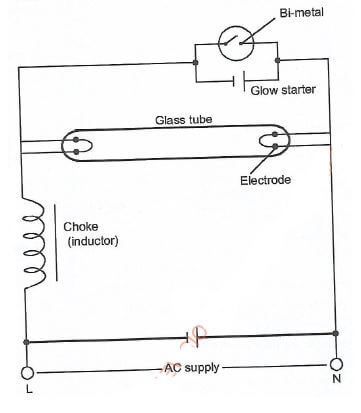
- Lamp fails to start and there is no end glow.
- No supply or fuse is broken.
- Tube life span expired.
- Burnt starter.
- Burnt choke.
- Broken electrode terminals.
- Fluorescent circuit
- Action to be taken on a victim in contact with live conductors:
Join our whatsapp group for latest updates
Tap Here to Download for 50/-
Get on WhatsApp for 50/-
Download KCSE 2018 Electricity Paper 1 with Marking Scheme.
Tap Here to Download for 50/-
Get on WhatsApp for 50/-
Why download?
- ✔ To read offline at any time.
- ✔ To Print at your convenience
- ✔ Share Easily with Friends / Students

